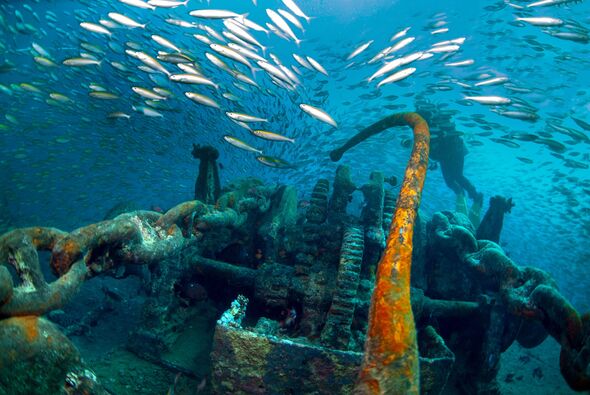World
British WWII Ship Transformed into Diver’s Haven in Red Sea

A British ship sunk by the Nazis during World War II has become a prominent attraction for divers worldwide. The **SS Thistlegorm**, measuring **413 feet**, rests in the **Red Sea**, having been submerged by a German bomber aircraft in **1941**. Today, divers can explore the wreck, which is home to stunning marine life and artifacts, including underwater jeeps and firearms that have remained on the seabed for over 80 years.
The wreck lies off the coast of **Egypt’s Ras Muhammad National Park**, a site popular among diving enthusiasts. According to **The Sun**, the Thistlegorm’s military cargo, which includes trucks, motorcycles, and weapons, draws divers eager to witness its preserved remnants. The ship remained undiscovered until **1952**, when renowned French naval officer and oceanographer **Jacques-Yves Cousteau** located it, following tips from local fishermen.
German forces, including their notorious U-Boat fleet, targeted supply vessels during the war. The Thistlegorm was en route to **Alexandria, Egypt**, carrying military equipment when it was attacked. As a **Defensively Equipped Merchant Ship (DEMS)**, it was armed with a **4.7-inch gun** and a heavy-calibre machine gun for anti-aircraft defense, according to the **National Maritime Museum**.
Iconic Diving Destination
In **2007**, the Thistlegorm was recognized as one of the top ten wreck diving sites in the world by **The Times**. Divers have the opportunity to navigate through the scattered remains of various military vehicles and equipment, or enjoy the vibrant marine life that surrounds the wreck. The nearby waters are teeming with biodiversity, featuring over **200 species of corals** and approximately **1,000 species of fish**, as reported by the **Red Sea Project**. Common sightings include tuna, batfish, moray eels, stonefish, and barracuda, along with occasional sea turtles.
Despite its allure, the wreck has faced deterioration over the years due to rust and damage from dive boats mooring at the site. To address these challenges, the **Hurghada Environmental Protection and Conservation Association** has implemented preservation measures. In December **2007**, they installed **32 mooring buoys** around the wreck and drilled holes in the hull to release trapped air. These steps were taken to safeguard the site for future divers and historians.
A Legacy Beneath the Waves
The Thistlegorm stands as a testament to the maritime history of WWII. It is one of many ships lost during the conflict, with some sunk in battles while others were intentionally scuttled to create dive sites and marine sanctuaries. As divers continue to explore this iconic wreck, they contribute to the ongoing legacy of the SS Thistlegorm, preserving its story for generations to come.
The transformation of the Thistlegorm into a diving paradise underscores the enduring impact of history beneath the waves, attracting adventurers keen to experience both the thrill of diving and the echoes of the past.
-

 Health3 months ago
Health3 months agoNeurologist Warns Excessive Use of Supplements Can Harm Brain
-

 Health3 months ago
Health3 months agoFiona Phillips’ Husband Shares Heartfelt Update on Her Alzheimer’s Journey
-

 Science1 month ago
Science1 month agoBrian Cox Addresses Claims of Alien Probe in 3I/ATLAS Discovery
-

 Science1 month ago
Science1 month agoNASA Investigates Unusual Comet 3I/ATLAS; New Findings Emerge
-

 Science1 month ago
Science1 month agoScientists Examine 3I/ATLAS: Alien Artifact or Cosmic Oddity?
-

 Science1 month ago
Science1 month agoNASA Investigates Speedy Object 3I/ATLAS, Sparking Speculation
-

 Entertainment5 months ago
Entertainment5 months agoKerry Katona Discusses Future Baby Plans and Brian McFadden’s Wedding
-

 Entertainment4 months ago
Entertainment4 months agoEmmerdale Faces Tension as Dylan and April’s Lives Hang in the Balance
-

 World3 months ago
World3 months agoCole Palmer’s Cryptic Message to Kobbie Mainoo Following Loan Talks
-

 Science1 month ago
Science1 month agoNASA Scientists Explore Origins of 3I/ATLAS, a Fast-Moving Visitor
-

 Entertainment2 months ago
Entertainment2 months agoLewis Cope Addresses Accusations of Dance Training Advantage
-

 Entertainment3 months ago
Entertainment3 months agoMajor Cast Changes at Coronation Street: Exits and Returns in 2025









